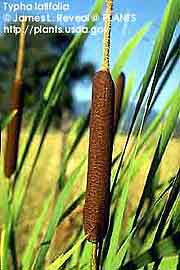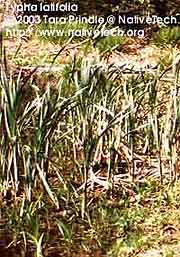

Medicine: Pollen is hemostatic & astringent. Place directly on cut to control bleeding. Take internally for internal bleeding, menstrual pain, chest pains, & other forms of blood stagnation. Pollen is also mildly diuretic and emenagogue. Use fresh, pounded root directly as a poultice on infections, blisters, & stings. Sticky starch at the base of the green leaf is antiseptic, coagulant, & even a bit numbing. Boil leaves for external skin wash. Starchy, mashed root use as a toothpaste. Drink root flour in a cup of hot water or eat the young flowerheads to bind diarrhea and dysentrery.
Technology: The leaves and stalks were used extensively in making sewn exterior mats for wigwams. String could also be made from fibers at the base of leaves. By folding a few leaves from the cattail stalk, Chippewa made simple dolls and small toy ducks that really float. The small ducks were usually made in groups of five to resemble a flock. The fluff from cattails was often used to insulate footwear in the winter, or to pad a baby's cradleboard.
Note: For additional information browse NativeTech's Uses for Cattails and Grasses
| <<- Previous Plant | ->> Next Plant |
 CATTAIL
CATTAIL